
The Undersea Explorer
This is an account of my second trip to The Great Barrier Reef and The Coral Sea aboard the Undersea Explorer. The Undersea Explorer mixes research and recreational diving for a truly fantastic experience. It is one of the few, if not the only, vessel that makes regular trips to Osprey Reef in The Coral Sea. For more information about the Undersea Explorer, please see their website at www.undersea.com.au.

The Undersea Explorer
This year's trip was organised by Dr Anya Salih and is a workshop to study coral colours called: Coral Reef Light and Life Workshop, or CoReLL Workshop, for short. Anya assembled a group of people from around the world:
Additionally, there were some tourists on board who came for the diving:

The People (James, Liz and Lee are missing from the photograph).
At around 8pm we boarded the boat for an introduction by Andy Dunstan in the dining area. Andy took us through the features of the boat, introduced the crew and gave us a strawman of the schedule for the trip.
Following Andy's talk, we migrated to the dry lab/multimedia area for an introductory talk by Anya and each of the guests introduced themselves and summarised their areas of expertise. At just after 9pm, James started the boat steaming towards the ribbon reefs.
We arrived at Challenger Bay at the southern end of Ribbon Reef #10 between 7 and 8 am after travelling all night from Port Douglas.
Just after 8 am, Steve started the main dive briefing for the trip. This included all the necessary safety directions for diving, such as safety stops, and rules for diving in an environmentally friendly way. This was followed by the briefing for the first dive at Challenger Bay.
Steve's dive briefings involved a site map for the dive, entry and exit points, recommendations for depth and dive profiles, and items of interest.

The site map of Challenger Bay for the first dive briefing.
The first day's diving was to allow people to orient themselves to diving (in case they haven't dived much recently) and to diving on the reef. The first dive was at Challenger Bay on Ribbon Reef #10, on the outer Great Barrier Reef. It was my first dive in clear water with the new camera which presented a number of new difficulties, mostly related to the amount of ambient light. Needless to say, most of the photographs from the dive are somewhat overexposed. Christy was my buddy and it was her first dive since completing basic and advanced diving instruction, not that you could tell that she didn't have much experience. (Dive details)
After a hot breakfast we moved on to Eagle Rock which is inside Ribbon Reef #10. Eagle Rock is a bommie in around 10 m of water, and most of the dive was spent swimming around the bommie. Shane was my buddy for the dive so I'm sure I'll end up in a lot of the scenes in the documentary. My photographs were a lot better from this dive as I got used to the camera and lighting conditions. (Dive details).
After the dive we had lunch and then the team met in the bio room to share our research interests and what we planned to do on the trip.
After the meeting. we did a dive at The Cod Hole, also on Ribbon Reef #10. The Cod Hole was first discovered by Ron and Valerie Taylor and is so named because of the large number of large cod (groupers) found in the area. Potato cod Epinephelus tukula are the most common in the area and as they have been hand fed over the years will swim right up to you. This can make photographing them very difficult as they are too large for the frame. Shane was my buddy again for this dive. (Dive details)
Following the dive at Cod Hole and after some afternoon tea, we met in the bio room again to hear a talk by Tony Larkum on PAM (Pulse Amplitude Modulation) Fluorimetry. We had two PAM devices on board the boat: a diving PAM which could be used for measuring photosynthesis on corals in situ and a large multi-channel device to measure corals brought back to the boat. Tony briefly discussed the processes of photosynthesis and quenching to explain how the PAM devices work.
We had planned a night dive at the Cod Hole, but due to a problem with the duck board we had to cancel the dive. The duck board had been raised so that the ROV could be put into the water, but it got stuck and could not be lowered. Once the crew managed to determine the cause of the problem it was too late for a dive and we had to make our way to Osprey Reef.
We travelled all night and reached Osprey Reef in time for an 8:30 am dive. The first dive of the day was at Admiralty Anchor, so named for an old style (admiralty) anchor imbedded in a swimthrough. Christy was my buddy and our plan was to went go to 30 m and then work our way back to the swimthrough. Unfortunately, we didn't find it, but still had a good dive. were quite common and I even saw a Paracentropyge multifasciatus. At one point I saw a mimic surgeon fish, Acanthurus pyroferus swimming with a C. heraldi which it was mimicking. The differences were obvious. (Dive details)
After breakfast we headed into the lagoon at Osprey and the first dive site was London Fog Bommie. There had been an interesting bleaching effect here where a warmer body of water had caused extensive bleaching at depth, while the shallower corals were fine. There was still good coral coverage at the site. On the way back to the boat I noticed a large crown-of-thorns starfish in a cave. (Dive details)
After lunch Mikhail Matz have us a talk on "How corals got their colours". He discussed GFP (Green Fluorescent Proteins) that were originally extracted from the bioluminescent jellyfish Aequorea victoria and the numerous GPF-like proteins that have since been extracted from corals. He explained how the colours of the proteins are determined at a genetic level, suggested when these proteins are likely to have evolved and whether the proteins are likely to be functional.
During the talk we headed over to Carden's Playground, a popular site for Dr Carden Wallace, the Acropora expert. This site had a large number of zoanthids of various species at around 15m. (Dive details)
After the dive at Carden's Playground, Jules gave us a talk on sharks and rays. She discussed form and function of elasmobranch anatomy and showed us some of the species we were likely to encounter on our dives.
For the night dive we headed back to London Fog Bommie. As I had seen the crown-of-thorns starfish in the cave near the boat, I was confident I would see it out on the reef and sure enough I did. This animal was huge. (Dive details)

The Crown-of-thorns starfish, Acanthaster planci.
On the Tuesday morning, we did our first dive at False Entrance on the western side of Osprey Reef. Tony was my buddy and he was looking for ascidians. This was a very enjoyable dive and we saw a lot of diversity in organisms. For an old fellar, he's very fit. (Dive details)
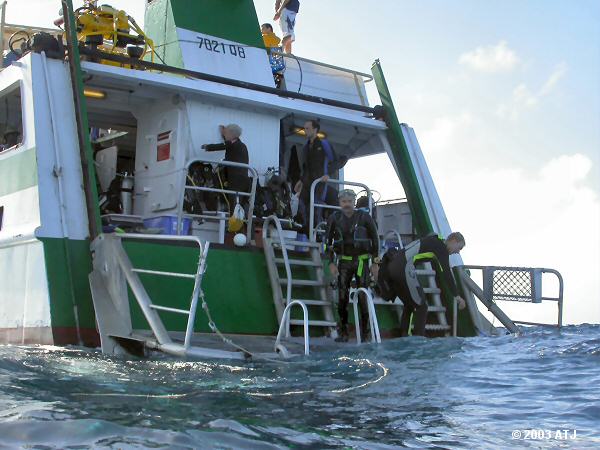 Dive deck of the Undersea Explorer
Dive deck of the Undersea Explorer
The second dive of the day was at North Horn at the northern end of Osprey Reef. Tony was my buddy again and so we looked for more ascidians. We started in around 27 m of water and gradually moved up the wall to the south of "The Pulpit" area that was to be used later for the "Shark Attract". Very soon into the dive I found two weedy scorpionfish, . Red firefish, and royal dottybacks, were common in the deep water. (Dive details)
Between dives, Joerg Wiedenmann presented a talk on "Molecular characterisations of novel fluorescent proteins". This was based on the work he is currently doing extracting GFP-like proteins from corals and other anthozoans. As GPF-like proteins are useful in various areas of research, particularly as markers, he discussed the pros and cons of some of the currently available proteins, including a very interesting one called "kaede" (Japanese for maple leaf) extracted from Trachyphyllia geoffroyi which starts off fluorescing green but when exposed to light of a certain wavelength changes to red.
The afternoon dive was a drop dive at North Horn. The boat dropped us off to the south of North Horn and we swam north along the wall, back to North Horn. We finished the dive pottering around in the shallows at North Horn. (Dive details)
Before the night dive, Jules, Christine and Steve took the inflatable out to drop the nautilus trap off the edge of the reef. The trap is lowered to around 300 m, baited with chicken and left overnight.
Night dive at Admiralty Anchor. Roberta, Ed, Ron, David and I swam along to the third bommie south of the anchor swimthrough to see the resident basket star. It was easy to find and was already putting on a show by the time we arrived. After snapping a few shots of the basket star, we headed back to the swimthrough to check out the flashlight fish. David had already gone on ahead so the 4 of us stopped part way through and switched our lights off and waited. Within a few minutes we saw single and then double small green/blue lights swimming round us. The single lights were the flashlight fish as seen from the side and as they turned to face us we could see both lights. After leaving the swimthrough, we slowly made our way back to the boat looking at various nocturnal organisms along the way. (Dive details)
The night dive was followed by a barbecue dinner which in turn was followed by drinking and singing.
First thing in the morning, Jules, Christine and Ed headed off in the inflatable to retrieve the nautilus trap. It was a successful night and they returned with 17 nautilus for measuring and tagging.
We made a short trip to Raging Horn for the morning dive. Christy and I had planned to go a spur in around 35 m of water but some 50 m or so along the reef wall. It was taking too long to get there so instead we dropped down the wall to check out the deeper areas. At around 30 m there was lots of large and other soft corals, a large with resident Amphiprion chrysopterus, many small Centropyge heraldii, many and two female? Genicanthus melanospilus. There were some white-tip reef sharks in one of the gutters. (Dive details)
After the dive, Jules measured, logged and tagged the nautilus caught on the previous night.

Jules preparing a nautilus for tagging.
Our early afternoon dive was the "Shark Attract at North Horn. We (the diving guests) get in position around "The Pulpit" and then the crew bring down two milk crates filled with fish heads and tails. The sharks are not actually fed, but merely attracted to the area for identification and counting. Many of the grey reef whalers and white-tip reef sharks have been tagged with microchip transmitters. A number of transponders in the area allow the movements of the tagged sharks to be tracked. Many grey reef whalers and white-tip reef sharks came in to the crates getting very close to those watching. (Dive details)
Connor made us pizza for lunch. "Mmm... pizza!".
For our last dive at Osprey Reef, we went to Coral Castles. Not only did I forget to bring my dive watch, but I also forgot to replace the battery in my camera so I was only able to take 13 photographs before the battery went dead. Nevertheless, it was an interesting dive and of course I saw many organisms I would have liked to have photographed. (Dive details)
After travelling all night from Osprey Reef, we arrive at Ribbon Reef #5 on the Great Barrier Reef just before 10 am. The morning's dive was at Pavona Clavus, so named for the large colony of Pavona clavus next to mooring line. I dived with Mikhail and we took it pretty easy. For this dive I was testing a combination of filters on the strobe and camera in an attempt to get photographs showing fluorescence in corals. A blue filter goes on the strobe to provide only blue light. The filter on the camera only allows light through that is at a higher wavelength than that coming from the strobe/filter combination. The setup works perfectly and I was able to get some stunning photographs for Anya. (Dive details)

 Hydnophora showing fluorescence and under normal lighting.
Hydnophora showing fluorescence and under normal lighting.
Following the dive we had a late breakfast and travelled to Steve's Bommie for the next dive. On the way, people caught up with work or sleep.
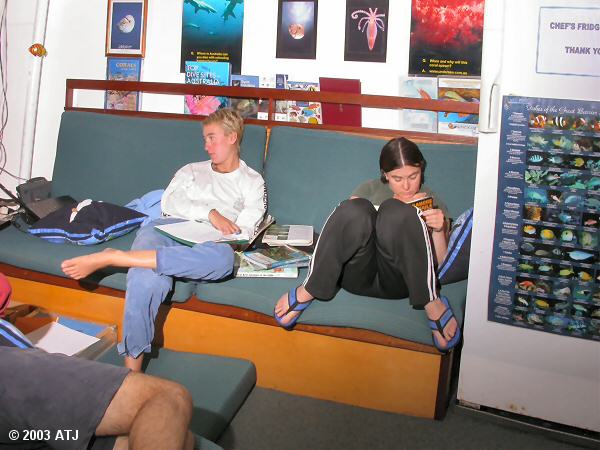
Jules vegging out and Christy catching up on her nudibranch identification.
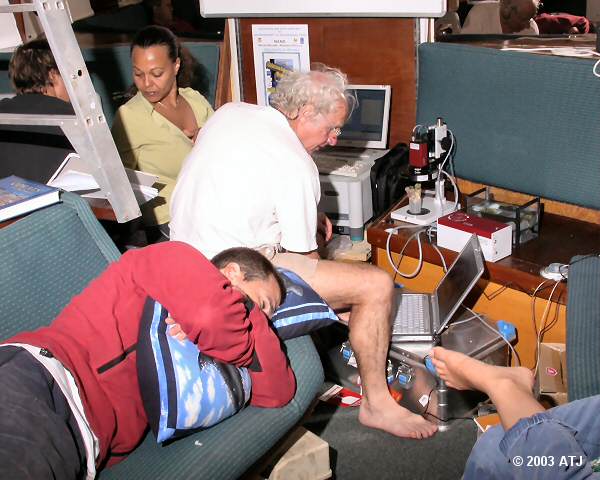
Anya and Tony taking some PAM readings. Alex catching up on some sleep.
At Steve's Bommie I dived with Mikhail again and while this site is always good, the strong current made it very hard work. I continued getting some great shots showing corals with fluorescent pigments. (Dive details)
Between dives, Steve Coles gave a talk on coral bleaching. He presented what is currently understood about bleaching events, such as the relationship between light and temperature, but also that there is a lot of information that is not yet known. The coral reefs appear to be in trouble due to global warming but the severity is still to be determined.
After lunch we headed down to Tracy's Wonderland for a late afternoon dive. (Dive details)
We stayed at Tracy's for the night dive. (Dive details)
Early morning drop dive at Nursery Bommie within the Agincourt Reef complex. It is a small bommie in around 25 m of water with the top of the bommie reaching to the surface. The first part of the dive was spent with Steve Coles, Tony Larkum and Uli Siggel generally looking around and taking photographs. The last part of the dive was spent with Andrew Baird in an attempt to take fluorescent photographs of recent coral recruits. The difficult part of the dive was the long swim back to the pickup point. (Dive details)

The Undersea Explorer as seen from the water after the dive on Nursery Bommie
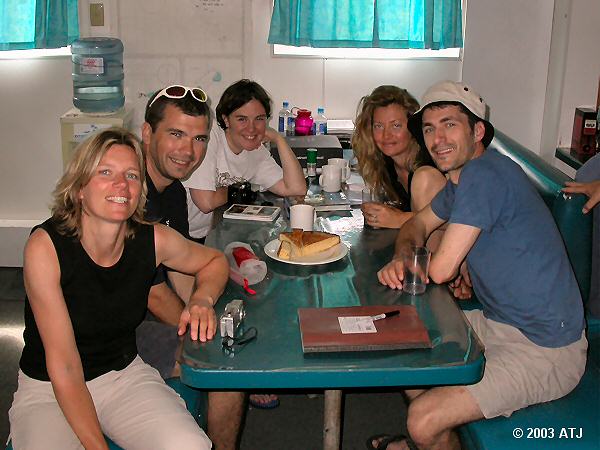
Christine, Alex, Christy, Roberta and Stefan
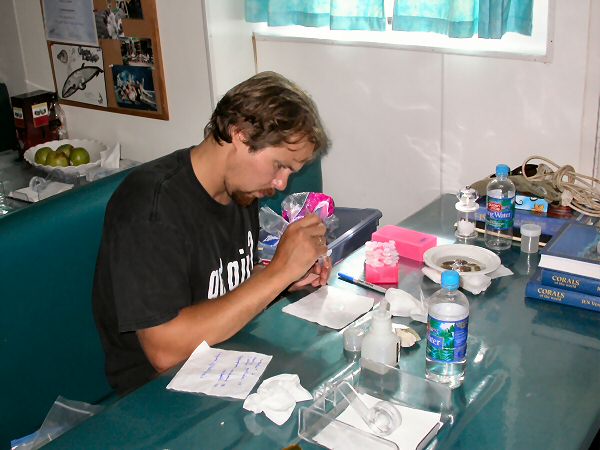
Mikhail hard at work
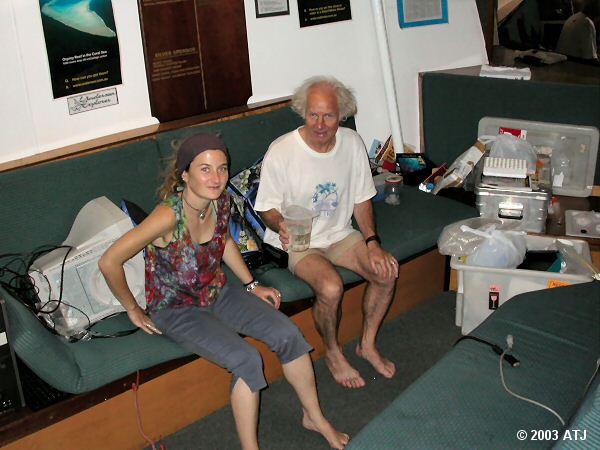
Giordana and Tony (with his seagrass, Halophila capricorni Larkum, 1995)

Shane and Lee look on as Liz updates her dive log
The second dive of the day and the last dive of the trip was at Chinaman's Reef, also part of the Agincourt Reef complex. This area had been devastated by crown-of-thorns starfish around six years earlier and we want to see how the reef was faring. Incredibly, there were a large number of coral species, including quite a few (maybe as many as 30) Acropora species. Andrew Baird and I tried some further fluorescent/coral recruitment photography. Like the previous dive, we have a very long swim back to be collected by the boat - in the end having to swim the boat down. (Dive details)

The Undersea Explorer as seen from the water after the dive on Chinaman's Reef
With the final dive completed, it was time for the four hour journey back to Port Douglas. On the way, Ron gave a talk on isotopes and oxygen radicals in the ocean, based on his work with ANSTO. The Undersea Explorer arrived back in Port Douglas at around 4:30 pm.
Last updated: 20 January 2004